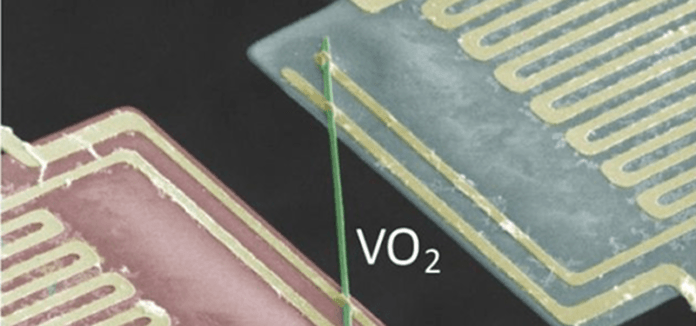All metals conduct electricity and heat relatively well. The electrical and thermal relation in metals is controlled by the Wiedemann-Franz Law. The Wiedemann-Franz law states that metals are the good conductors of electricity and heat as well. But now, a new rule breaker material came up. Scientists have created new metal that only conduct electricity but not heat.
This new discovery by an international team of scientists adds more evidence to back up the metal’s nonconformist reputation. It states that electrons in vanadium dioxide can conduct electricity without conducting heat.
Study principal investigator Junqiao Wu said, “This was a totally unexpected. It shows a drastic breakdown of a textbook law that has been known to be robust for conventional conductors. This discovery is of fundamental importance for understanding the basic electronic behavior of novel conductors.”
During examining the properties of vanadium dioxide, scientists used results of simulations and X-ray scattering experiments. Thus, they were able to provoke the proportion of thermal conductivity attributable to the vibration of the material’s crystal lattice, called phonons, and to the movement of electrons. They found that the thermal conductivity is associated with the electrons. The electrons are ten times smaller than expected from the Wiedemann-Franz Law.
Wu said, “The electrons were moving in unison with each other. They are moving like a fluid, instead of as individual particles like in normal metals.”
“For electrons, heat is a random motion. Normal metals transport heat efficiently. It because of there is so many different possible microscopic configurations that the individual electrons can jump between. In contrast, the coordinated, marching-band-like motion of electrons in vanadium dioxide is detrimental to heat transfer. This is like, only fewer configurations available for the electrons to hop randomly between.”
When the researchers’ doped single crystal vanadium dioxide samples with the metal tungsten, they lowered the phase transition temperature at which vanadium dioxide becomes metallic.
At the same time, the electrons in the metallic phase became better heat conductors. Thus researchers can control the amount of heat that vanadium dioxide can dissipate. This is done by switching its phase from insulator to metal and vice versa, at tunable temperatures.
Study co-author Fan Yang said, “This material could be used to help stabilize temperature. By tuning its thermal conductivity, the material can efficiently and automatically dissipate heat. This because it will have high thermal conductivity. But it will prevent heat loss in the cold winter because of low thermal conductivity at lower temperatures.”
According to scientists, such metals can become useful to scavenge or dissipate the heat in engines. In addition, it might be used to develop window coating that improves the efficient use of energy in buildings.
